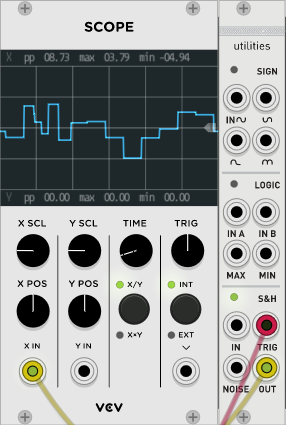Overview
This is yosi from Chillout with Beats.
VCV RackThis is the thirteenth article.
Click here for previous article

Continuing from the last time, we will introduce recommended modules.
this time too, Mutable Instruments Was the baseAudible Instruments.
I've been searching a lot lately and I see pictures of real modular synths, but no ~Mutable Instruments It's very popular.Approximately one or two are built in.
It's an auxiliary module, so it goes smoothly.
Mutable Instruments It worked like I saw it for the first time with this product.
I was so happy that I made a demo sound source.I've been listening to Lo-Fi Hiphop recently, so I'm influenced by it.
I don't think many people know that it's modular and can make this kind of sound.
allVCV RackI'm making it. (The sample is played by Player)
Multiples (Links)

This is the official explanation.
Links provides three utility functions focused on signal distribution and mixing.
I don't know what the explanation is, but it means that there are three sections, each with a different mixing method.
Key Points
1:3Is evenly distributed.
Can be used as a splitter.
2:2Will be added.
It can be used when the sound is quiet or when you want to multiply different waveforms.
You can also use this to create a complex LFO.
You can also mute by applying a waveform of the opposite phase.
3:1Will be averaged.
2:2It is similar to, but it averages 3 INs, so it can be used to mix 3 LFOs or an oscillator without making the waves bigger. (Can be used to avoid clipping)
1: 3 SECTION
This section of the module is a buffered multiple. The signal patched to the IN input is replicated to each of the three OUT outputs without a voltage drop.
In this section, you can send Note CVs to multiple VCOs from a keyboard, sequencer, or MIDI interface.However, you can also distribute audio signals and modulations across multiple modules.
2: 2 SECTION
This section acts as a precision adder / mixer and multiple. Two signals patched to the IN input are added and the result is available on each of the two OUT outputs.
Of course, you can also use this section as a multiple of 1: 2. If only one of the IN inputs is unpatched.
This section uses a precision adder circuit, so it is possible to use it to transpose a note CV.For example, patch the sequencer's CV output to the first input and the keyboard's CV output to the second input.Patch the output to the VCO.In this patch, the sequence is replaced by the keyboard.
Audio or modulated signals can also be mixed and / or muted in this section.
3: 1 SECTION
This section acts as an average.The three signals sent to each IN input are mixed and a 3/1 gain is applied to the mix.This is especially useful for mixing audio signals without causing clipping.
Summary
This time it was really the same.There was no such thing as a hidden parameter in the manual either.
However, the usage is deep. Good control of the shape of the LFO can have interesting effects.
It ’s more fun than I expected, soSoftube ModulerOrCherry Audio Voltage ModularI felt like I wanted a hit.
Each has its own characteristics, so I'll write an article comparing this area.


Comment